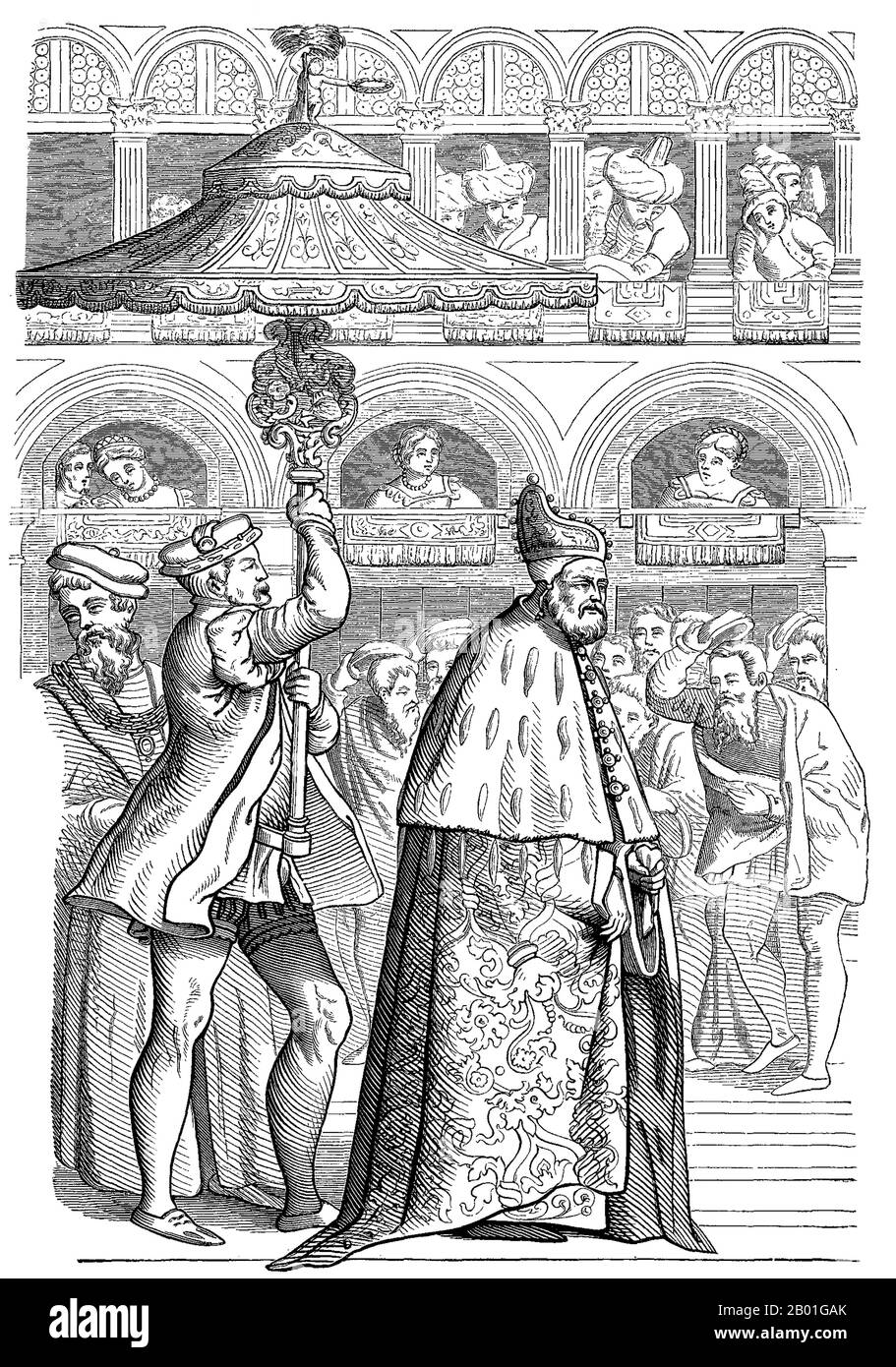Dux venice Black & White Stock Photos
 The Doge of Venice (derived from Latin dux, 'leader'), often mistranslated Duke (the Italian word for duke is 'Duca') was the chief magistrate and leader of the Most Serene Republic of Venice for over a thousand years. Doges of Venice were elected for life by the city-state's aristocracy. Commonly the person selected as Doge was the shrewdest elder in the city. Contrary to popular belief the doge was not a duke in the modern sense, nor was a doge the equivalent of a hereditary duke. The doge was the senior-most elected official of Venice and Genoa; both cities were republics and elected doges Stock Photohttps://www.alamy.com/image-license-details/?v=1https://www.alamy.com/the-doge-of-venice-derived-from-latin-dux-leader-often-mistranslated-duke-the-italian-word-for-duke-is-duca-was-the-chief-magistrate-and-leader-of-the-most-serene-republic-of-venice-for-over-a-thousand-years-doges-of-venice-were-elected-for-life-by-the-city-states-aristocracy-commonly-the-person-selected-as-doge-was-the-shrewdest-elder-in-the-city-contrary-to-popular-belief-the-doge-was-not-a-duke-in-the-modern-sense-nor-was-a-doge-the-equivalent-of-a-hereditary-duke-the-doge-was-the-senior-most-elected-official-of-venice-and-genoa-both-cities-were-republics-and-elected-doges-image344242155.html
The Doge of Venice (derived from Latin dux, 'leader'), often mistranslated Duke (the Italian word for duke is 'Duca') was the chief magistrate and leader of the Most Serene Republic of Venice for over a thousand years. Doges of Venice were elected for life by the city-state's aristocracy. Commonly the person selected as Doge was the shrewdest elder in the city. Contrary to popular belief the doge was not a duke in the modern sense, nor was a doge the equivalent of a hereditary duke. The doge was the senior-most elected official of Venice and Genoa; both cities were republics and elected doges Stock Photohttps://www.alamy.com/image-license-details/?v=1https://www.alamy.com/the-doge-of-venice-derived-from-latin-dux-leader-often-mistranslated-duke-the-italian-word-for-duke-is-duca-was-the-chief-magistrate-and-leader-of-the-most-serene-republic-of-venice-for-over-a-thousand-years-doges-of-venice-were-elected-for-life-by-the-city-states-aristocracy-commonly-the-person-selected-as-doge-was-the-shrewdest-elder-in-the-city-contrary-to-popular-belief-the-doge-was-not-a-duke-in-the-modern-sense-nor-was-a-doge-the-equivalent-of-a-hereditary-duke-the-doge-was-the-senior-most-elected-official-of-venice-and-genoa-both-cities-were-republics-and-elected-doges-image344242155.htmlRM2B01GAK–The Doge of Venice (derived from Latin dux, 'leader'), often mistranslated Duke (the Italian word for duke is 'Duca') was the chief magistrate and leader of the Most Serene Republic of Venice for over a thousand years. Doges of Venice were elected for life by the city-state's aristocracy. Commonly the person selected as Doge was the shrewdest elder in the city. Contrary to popular belief the doge was not a duke in the modern sense, nor was a doge the equivalent of a hereditary duke. The doge was the senior-most elected official of Venice and Genoa; both cities were republics and elected doges
 Doge of Venice. Pre-16th century costume, whose cloak was open from top to bottom, fastened at the right shoulder with a button, and dangling from the left. The collar is surrounded by ermine. Engraving after Cesare Vecellio (1530-1601) in 'De gli habiti antichi et moderni di diversi parti del mondoi'. Venice, 1590. 'Moeurs, usages et costumes au moyen-âge et à l'époque de la Renaissance', by Paul Lacroix. Paris, 1878. Stock Photohttps://www.alamy.com/image-license-details/?v=1https://www.alamy.com/doge-of-venice-pre-16th-century-costume-whose-cloak-was-open-from-top-to-bottom-fastened-at-the-right-shoulder-with-a-button-and-dangling-from-the-left-the-collar-is-surrounded-by-ermine-engraving-after-cesare-vecellio-1530-1601-in-de-gli-habiti-antichi-et-moderni-di-diversi-parti-del-mondoi-venice-1590-moeurs-usages-et-costumes-au-moyen-ge-et-lpoque-de-la-renaissance-by-paul-lacroix-paris-1878-image594990222.html
Doge of Venice. Pre-16th century costume, whose cloak was open from top to bottom, fastened at the right shoulder with a button, and dangling from the left. The collar is surrounded by ermine. Engraving after Cesare Vecellio (1530-1601) in 'De gli habiti antichi et moderni di diversi parti del mondoi'. Venice, 1590. 'Moeurs, usages et costumes au moyen-âge et à l'époque de la Renaissance', by Paul Lacroix. Paris, 1878. Stock Photohttps://www.alamy.com/image-license-details/?v=1https://www.alamy.com/doge-of-venice-pre-16th-century-costume-whose-cloak-was-open-from-top-to-bottom-fastened-at-the-right-shoulder-with-a-button-and-dangling-from-the-left-the-collar-is-surrounded-by-ermine-engraving-after-cesare-vecellio-1530-1601-in-de-gli-habiti-antichi-et-moderni-di-diversi-parti-del-mondoi-venice-1590-moeurs-usages-et-costumes-au-moyen-ge-et-lpoque-de-la-renaissance-by-paul-lacroix-paris-1878-image594990222.htmlRM2WG042P–Doge of Venice. Pre-16th century costume, whose cloak was open from top to bottom, fastened at the right shoulder with a button, and dangling from the left. The collar is surrounded by ermine. Engraving after Cesare Vecellio (1530-1601) in 'De gli habiti antichi et moderni di diversi parti del mondoi'. Venice, 1590. 'Moeurs, usages et costumes au moyen-âge et à l'époque de la Renaissance', by Paul Lacroix. Paris, 1878.